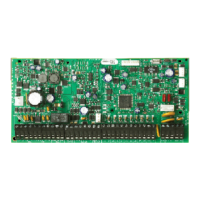EVO Installation Guide 121
Appendix D: Guidelines for Locating Smoke Detectors and CO Detectors
The following information is for general guidance only and it is recommended that local fire codes and
regulations be consulted when locating and installing smoke and CO alarms.
Smoke Detectors
Experiments with typical fires in homes indicate that detectable quantities of smoke precede detectable levels
of heat in most cases. For these reasons, smoke alarms should be installed outside of each sleeping area and on
each storey of the home.
The following information is for general guidance only and it is recommended that local fire codes and
regulations be consulted when locating and installing smoke alarms. It is recommended that additional smoke
alarms beyond those required for minimum protection be installed.
Additional areas that should be protected include: the basement; bedrooms, especially where smokers sleep;
dining rooms; furnace and utility rooms; and any hallways not protected by the required units. On smooth
ceilings, detectors may be spaced 9.1m (30 feet) apart as a guide. Other spacing may be required depending on
ceiling height, air movement, the presence of joists, un-insulated ceilings, etc.
Consult National Fire Alarm Code NFPA 72, CAN/ULC-S553-02 or other appropriate national standards for
installation recommendations. •
Warning: Do not locate smoke detectors at the top of peaked or gabled ceilings; the dead air space in
these locations may prevent the unit from detecting smoke. • Avoid areas with turbulent air
flow, such as near doors, fans or windows. Rapid air movement around the detector may
prevent smoke from entering the unit. • Do not locate detectors in areas of high humidity. •
Do not locate detectors in areas where the temperature rises above 38
o
or below 5
o
C
Smoke detectors should always be installed in USA in accordance with Chapter 11 of NFPA 72, the National Fire
Alarm Code: 11.5.1.1.
Where required by applicable laws, codes, or standards for a specific type of occupancy, approved single- and
multiple-station smoke alarms shall be installed as follows:
1. In all sleeping rooms and guest rooms.
2. Outside of each separate dwelling unit sleeping area, within 6.4 m (21 ft) of any door to a sleeping room,
the distance measured along a path of travel.
3. On every level of a dwelling unit, including basements.
4. On every level of a residential board and care occupancy (small facility), including basements and
excluding crawl spaces and unfinished attics.
5. In the living area(s) of a guest suite.
6. In the living area(s) of a residential board and care occupancy (small facility).
CO detectors
Install one CO detector in each room that has a fuel burning appliance.
Make sure the alarm can be heard in the sleeping quarters of the building.

